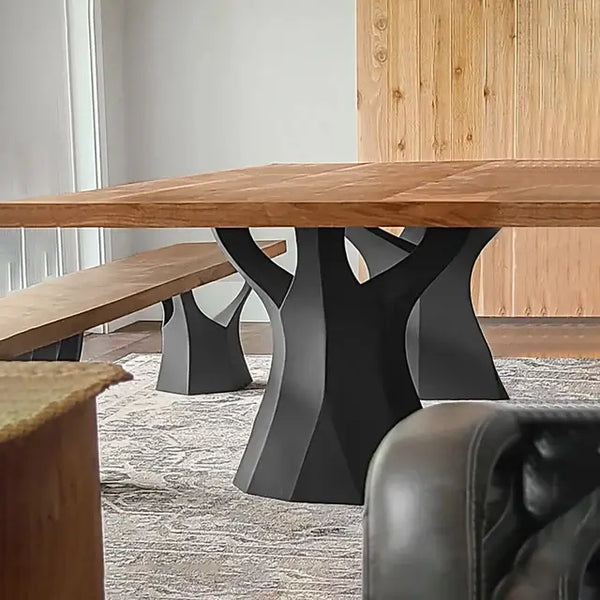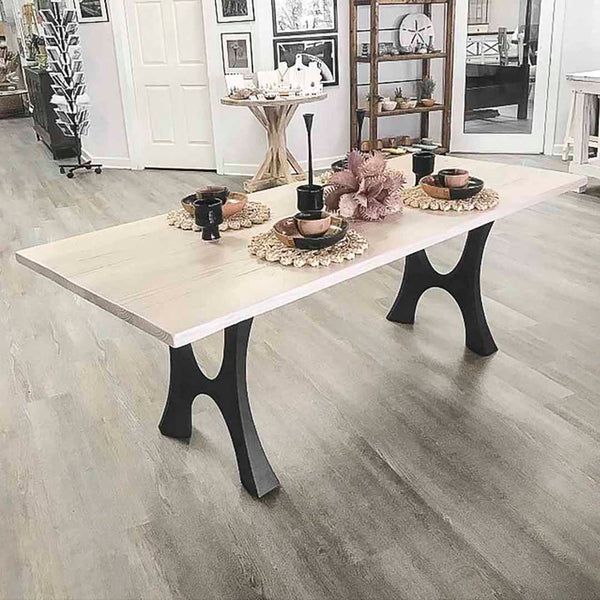Creative Ideas for Replacing or Refurbishing Your Dining Room Table Legs
Creative Ideas for Replacing or Refurbishing Your Dining Room Table Legs
Blog Article
Specialist Tips for Putting Up Dining-room Table Legs for Maximum Stability
When it comes to setting up eating room table legs, attaining optimum stability is extremely important for both functionality and appearances. What particular strategies can boost security even better?
Pick the Right Legs
When picking the proper legs for your dining-room table, it is necessary to consider both performance and aesthetic appeals. The legs you choose will significantly impact the total layout and stability of the table. First, evaluate the table's meant use; if you expect frequent gatherings, sturdier legs, such as those made from strong timber or steel, may be preferable, as they offer increased resilience and support.
Next, take into consideration the height and style of the legs in regard to the tabletop. Basic eating tables generally range from 28 to 30 inches in height, so ensure the legs straighten with this standard for comfort. The style of the legs must match the layout of the table top-- whether it be modern, rustic, or conventional. As an example, conical legs can include a contemporary touch, while turned legs may convey a much more classic visual.

Select Appropriate Hardware
Exactly how can the appropriate equipment improve the stability and longevity of your dining room table? The choice of ideal equipment is important to making certain that the legs of your table are firmly attached and able to stand up to regular use. High-grade screws, screws, and brackets give the necessary toughness to support the weight of the table, in addition to any additional tons positioned upon it during celebrations or meals.
When picking screws, choose those made from long lasting products such as stainless-steel or brass, which resist rust and maintain honesty with time. The size of the screws is equally essential; they ought to penetrate deeply into the table's framework without compromising integrity. For bolted connections, think about utilizing lock washers to stop loosening due to vibration or motion.
In addition, utilizing corner braces can include extra support, particularly for bigger tables or those with heavier tops. These brackets disperse weight uniformly and aid preserve the table's form. Ensuring that the hardware you pick is appropriate for the specific products of your table will additionally boost its overall security and longevity, allowing you to enjoy your eating experience for many years ahead.
Ensure Proper Positioning
Correct placement of eating room table legs is necessary for both aesthetic allure and practical stability. Misaligned legs can bring about an uneven table top, which might not just be visually unattractive yet also compromise the table's functionality. To achieve optimal placement, begin by measuring the distance from the table's corners to the leg accessory factors. This guarantees that each leg is positioned equidistant from the sides, creating a balanced appearance.
Make use of a degree review during installment additional hints to confirm that each leg is vertical to the tabletop. It is advisable to mark the desired leg placements on the underside of the table with a pencil or concealing tape before protecting them.
Moreover, ascertain the placement after the initial screws are tightened up, as adjustments may be needed prior to totally securing the equipment. By focusing on proper positioning, you not just improve the table's overall design but likewise make sure that it stays functional and steady for years to come.
Consider Weight Circulation
After ensuring correct placement of the eating area table legs, it is very important to think about weight distribution to enhance stability and functionality. dining room table legs. Appropriate weight distribution is essential in stopping ensuring and tottering that the table can sustain its intended lots without threat of tipping or breaking down
When positioning the legs, ensure they are positioned at equivalent ranges from the facility of the table to uniformly distribute the weight across the framework. Take into consideration the weight of the table top and any things that will regularly hinge on it, such as decorative items or tabletop devices. Tables with heavier surface areas need to ideally have legs positioned closer to the edges, as this takes full advantage of the base of assistance and lessens the risk of instability.
Furthermore, if the table is planned for usage in a high-traffic location, take into consideration utilizing larger products for the legs or adding supporting elements, such as cross-bracing or a reduced rack - dining room table legs. These adjustments can help keep equilibrium and protect against moving throughout use. Ultimately, a well-considered weight distribution strategy will dramatically enhance the table's general efficiency, guaranteeing it continues to be a functional and appealing focal point for your dining space
Test Stability Before Use
Testing the security of the eating space table before use is a crucial action that needs to not be ignored. If the table shows instability, identify the legs or joints that might require adjustment.
Next, inspect that all screws and fasteners are tightened appropriately. Loose connections can bring about instability and prospective damage over time. If essential, utilize wood adhesive on joints to improve stability, ensuring to permit appropriate drying time.

Final Thought
To conclude, the setup of eating room table legs needs mindful consideration of materials, hardware, weight, and positioning circulation to attain maximum stability. By choosing tough legs and top quality bolts, ensuring precise alignment, and distributing weight image source equally, the architectural honesty of the table can be considerably improved. Carrying out a security examination before normal usage further guarantees that the table will stand up to day-to-day stress, therefore giving a risk-free and trustworthy eating experience.
When it comes to mounting eating space table legs, accomplishing maximum stability is critical for both functionality and aesthetic appeals. The legs you select will substantially affect the overall design and stability of the table (dining room table legs). Standard eating tables commonly vary from 28 to 30 inches in elevation, so guarantee the legs align with this standard for convenience.Appropriate positioning of dining area table legs is crucial for both visual allure and practical stability.In conclusion, the installment of dining room table legs requires mindful consideration of materials, hardware, weight, and placement circulation to achieve optimum security
Report this page